Canoeing is a great way to enjoy the outdoors and get some exercise, but it can be expensive. A new canoe can cost up to several thousand dollars, making it out of reach for many people.
However, used canoes are much more affordable, and they can be just as good as new ones. Plus, buying a used canoe is a great way to support sustainable practices.
When you purchase a used canoe, you are keeping it out of landfills and giving it a second life.
So, if you’re looking for a great way to enjoy the water without breaking the bank, consider getting a used canoe. You’ll be glad you did.
In fact, many used canoes are often still comparable to new ones because they have been well-maintained by their previous owners.
Sometimes, people need to sell their used canoes such as wanting to upgrade to a newer model or needing some cash for other purposes.
If you’re wondering how much is used canoes, then you’re at the right place.
In this article, I answer how much, what to look out for, and other important questions that you may concern about buying used canoes.
Table of Contents
How Much Are Used Canoes?
There is no exact answer to the price of used canoes. The average price of a Canoe is $1200 for new and $700 for used.
Prices do vary widely according to quality (age, model), materials, and condition, how well it has been maintained over its lifetime and the types of canoes.
Because high-end canoes are not mass-produced but rather handcrafted and made in limited supply so the price is very high.
Used Canoes Vs New Canoes: What’s the Difference?
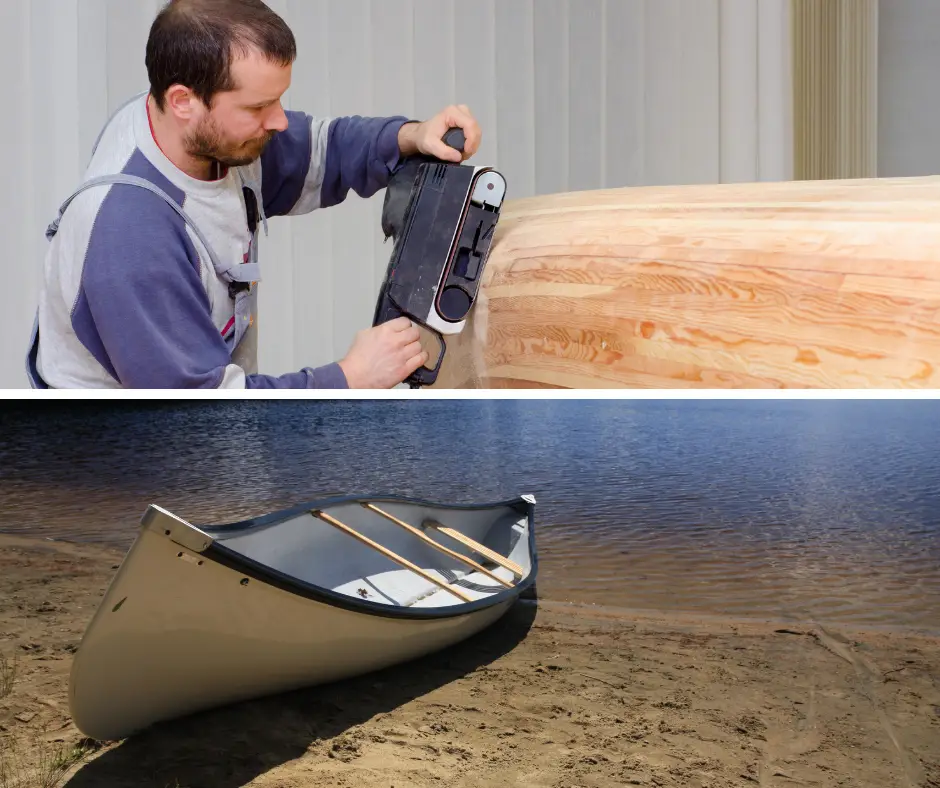
There are a few key differences between used and new canoes. The first is, of course, the price. As I mentioned above, used canoes are much more affordable than new ones. However, you may have to sacrifice some features if you’re on a budget.
For example, used canoes may not have all the bells and whistles that new ones do, such as built-in GPS or fish finders.
Another key difference between used and new canoes is the warranty. Most new canoes come with a manufacturer’s warranty that covers defects and damages. Used canoes usually don’t have a warranty. This means that if something goes wrong, you’ll have to pay for repairs or replacements out of pocket.
Finally, used canoes may not be as reliable as new ones. This is because they may have hidden damage that you’re not aware of.
For example, a used canoe may have a small crack in the hull that’s not visible to the naked eye. This type of damage can cause the canoe to leak or even sink.
So, if you’re considering buying a used canoe, be sure to inspect it thoroughly and ask about its history. It’s also a good idea to purchase from a reputable dealer who can offer a written warranty.
But, if you’re still on the fence about whether you want to buy either a new or used canoe, here are some of the pros and cons of each.
Cons of buying a used canoe:
- Sometimes the damage on used canoes may not be observable to the naked eye such as minor fractures but they can build up over time.
- Don’t usually come with a warranty especially if you’re buying from an individual.
- You usually don’t get to test a used canoe before you buy it.
Pros of buying a used canoe:
- Used canoes don’t suffer too much from depreciation.
- Sellers are often open to negotiation and may even accept trades.
- Often priced significantly lower than new canoes even if they’ve just been used a few times.
- Buyers can use the savings to buy upgrades such as fish finders and motors.
- Used canoes are often difficult to recycle thus you’ll be helping the environment by keeping it from landfills.
- You can buy only exactly what you need and none of the new technologies manufacturers are pushing through new models.
However, getting a new canoe presents its own set of pros and cons. Here are some of them:
Cons of buying a new canoe:
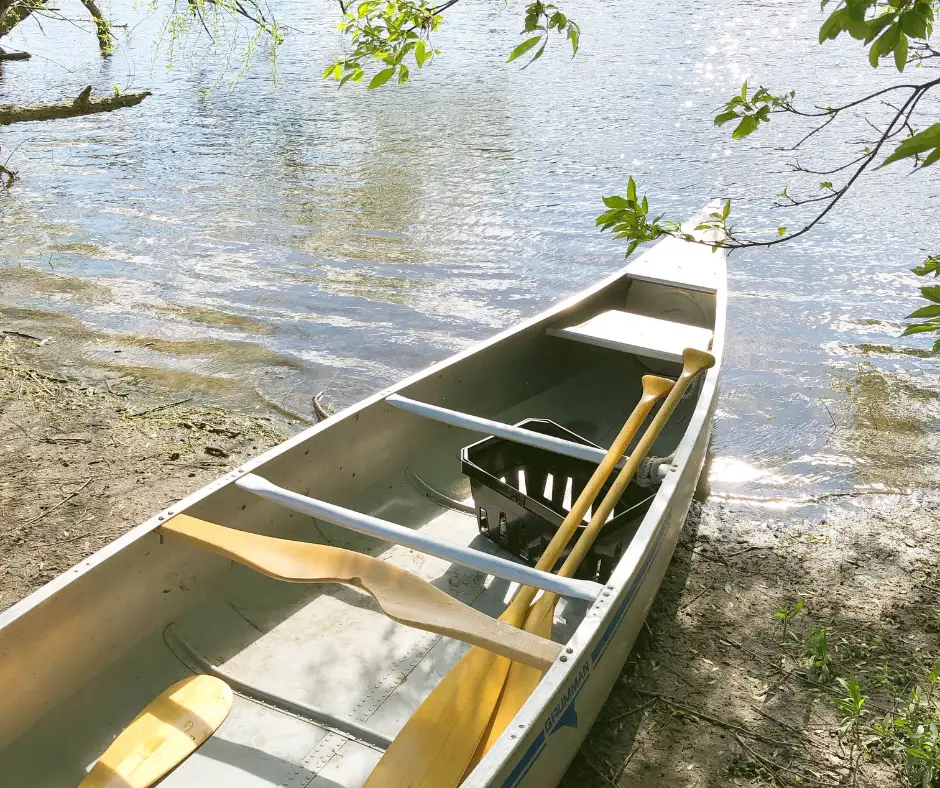
- The full price of new canoes can be prohibitive, especially for beginners.
- Depreciation starts immediately upon purchase with a rate of 20% after the first year and 10% in succeeding years.
- There’s no way to negotiate with a store that’s out to make a profit.
- Additional taxes may be required hiking the prices of a new canoe even more.
Pros of buying a new canoe:
- Shops are more open to letting customers try a new canoe before they sell it.
- The warranty on used canoes can give you peace of mind especially when out in the water.
- Dealers often offer returns which is excellent news for people who are just trying out the hobby.
- Manufacturers and dealers often give new canoes two layers of quality checks before handing them out to the customer.
- You’ll get all the modernizations and technologies in new canoes.
How To Get a Good Deal on a Used Canoe?
The price of a used canoe can vary greatly depending on factors like quality, age, specific model, and how well it has been taken care of during its lifetime.
In general, however, you can expect to pay anywhere from 70% to 50% for a used well-maintained canoe.
For certain models, even this kind of price reduction can still mean thousands of dollars. We’re here to make sure you don’t overpay.
below are a few tips to help you get a good deal on a used canoe.
Know what type of canoeing you intend to do.
The type of canoeing you want to do will play a big role in what kind of canoe you need. For instance, if you want to go river canoeing, you’ll need a different type of canoe than if you were planning on lake canoeing.
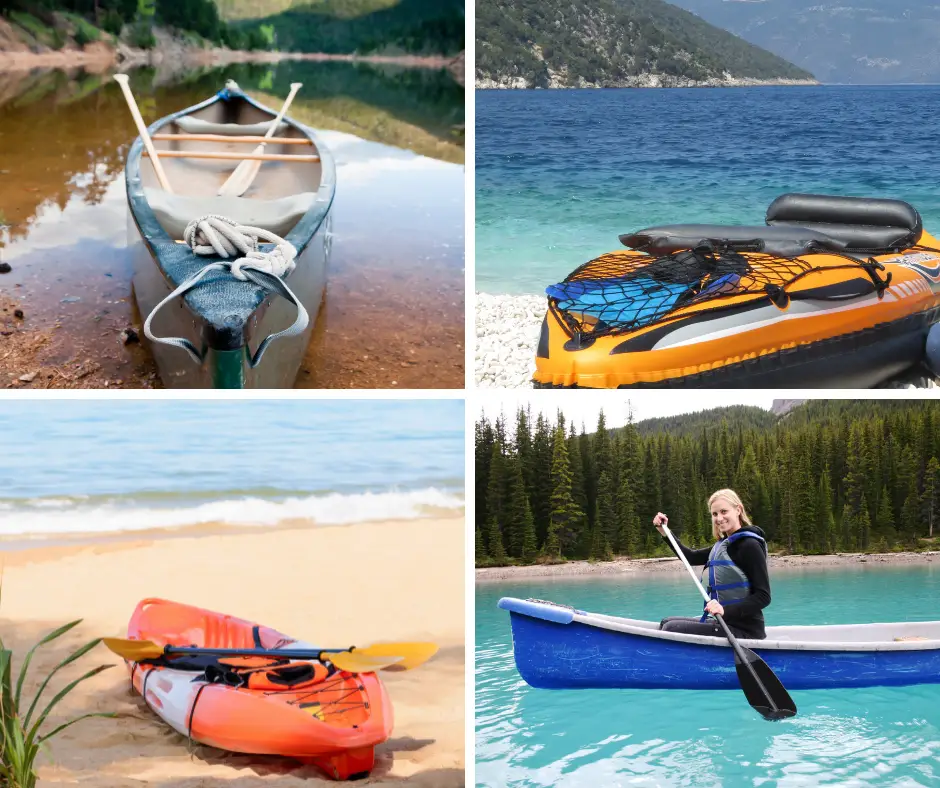
Canoe Types
There are 5 common types of canoes: lakewater or touring, expedition, racing or training, recreational, sportsman, and whitewater. There are also solo and tandem canoe types that can heavily affect the price.
Knowing exactly what type of canoe you’ll need can help you save a lot of money as you won’t be paying for features that you don’t actually need.
Material
The material of your canoe will also affect the price. The 3 most common materials used for canoes are aluminum, Royalex, and fiberglass.
Of these, Royalex is the most expensive but it’s also the most durable. Fiberglass is a close second in terms of durability but it’s much lighter than Royalex. Aluminum is the least expensive but it’s also the least durable.
It’s important to pick a material that will be able to withstand the type of canoeing you want to do.
There are other, more specialized materials.
Wood – One of the more expensive and maintenance-heavy materials but is still in production because of the nostalgia of using canoe material that has been in use for thousands of years.
Inflatables – Lightweight, durable, and generally, inexpensive. However, you need to be on the cautious side as they can often hide some critical damages that may significantly affect its durability and long-term viability.
Kevlar, carbon, and graphite – Extremely lightweight without sacrificing durability. However, they can also be extremely expensive so even if you’re buying them second-hand, you’ll still have to pay thousands of dollars.
Thermoform – Inexpensive, durable, and essentially maintenance-free. However, all these benefits come at the cost of weight as these make canoes extremely heavy.
Look over the canoe’s condition.
One of the most important things to consider when buying a used canoe is its condition.
Look for signs of wear and tear, as well as any damage that may have been caused by impact or exposure to harsh weather conditions.
It’s also important to check for leaks, as even a small leak can cause serious problems in the water.
Finally, make sure that the yoke is stable and in good condition. A used canoe can be a great investment, but only if it’s in good condition.
By taking the time to inspect a used canoe carefully, you can avoid any problems down the road.
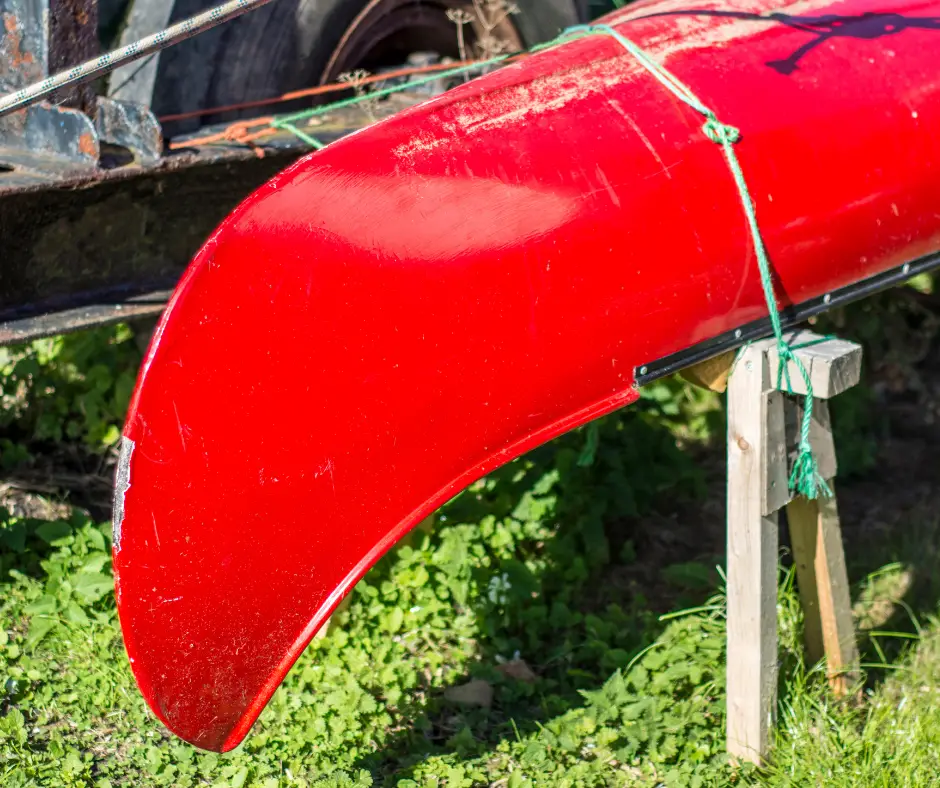
Reliability and reputation of the dealer or owner.
If you’re buying from an individual, it’s important to take the time to get to know them and their canoe. How long have they had it? How well have they taken care of it? What type of canoeing have they done with it?
It’s also important to make sure that the dealer or owner is reliable and trustworthy. Ask for references and try to get in touch with some of their past customers. If possible, inspect the canoe in person before making a purchase.
Similarly, if you’re purchasing from a dealer, you can check out the shop’s reputation before you pull the trigger on a used canoe. There are often reviews readily available on online forums and other websites.
Where Can I Buy A Used Canoe?
If you’re looking for a used canoe on a budget, your best bet is to check classifieds websites such as Craigslist or Kijiji, or local garage sales. You may be able to find a decent canoe for under $500 this way.
However, be sure to inspect the canoe thoroughly before making a purchase, as there is no guarantee of its condition.

Or, you can also find canoes for sale in online communities such as Facebook groups for paddlers. Similarly, you may also find some canoes for sale in your local paddling community. Just don’t be afraid to ask around at the clubhouse and they’ll point you in the right direction.
If you’re willing to spend more money on a used canoe, you may want to consider purchasing from a reputable dealer. Canoe dealers typically sell both new and used canoes, so they should be able to help you find a high-quality used canoe that fits your budget.
Just be sure to ask about the canoe’s history and get a written warranty before making your purchase.
You’re going to want to check what’s in the market during the spring or fall as canoeists put their equipment on sale during these times to get ready for the upcoming season.
12 Best Canoes With New and Used Prices
We’ve rounded up 12 of the most commonly used canoes up for sale. We’ve chosen to feature these because they fit a wide range of budgets and a wide selection of use cases.
| Canoe Brand | Model | New Price | Secondhand Price |
| Old Town | Discovery 133 (Old Town) | $1,349.99 | $800 |
| Nova Craft | Prospector SP3 16′ (Nova Craft) | $1,600 | $900 |
| Esquif | Blast – Whitewater (Esquif) | $2,000 | $900 |
| Clipper | Tripper (Kevlar) 17’6″ (Clipper) | $2,000 | $1,700 |
| Mad River | Explorer (Royalex/Formex) (Mad River) | $2,200 | $1,400 |
| Grumman | Eagle 17′ or Square Stern 17′ (Grumman) | $2000 – 2,800 | $750 – $1,900 |
| H2O | Prolite Prospector (H2O) | $2,500 | $1,950 |
| Souris River | Quetico 18′ (Kevlar) (Souris River) | $2,600 | $1,600 |
| Wenonah | Encounter (Tuf-Weave) Solo (Wenonah) | $2,900 | $2,000 |
| Clipper | MacKenzie (Kevlar) 18′ (Clipper) | $2,950 | $2,000 |
| Wenonah | Minnesota II (Tuf-Weave) – Wenonah | $3,100 | $1,850 |
| Wenonah | Minnesota III (Tuf-Weave) (Wenonah) | $3,500 | $2,150 |
Old Town Discovery 133
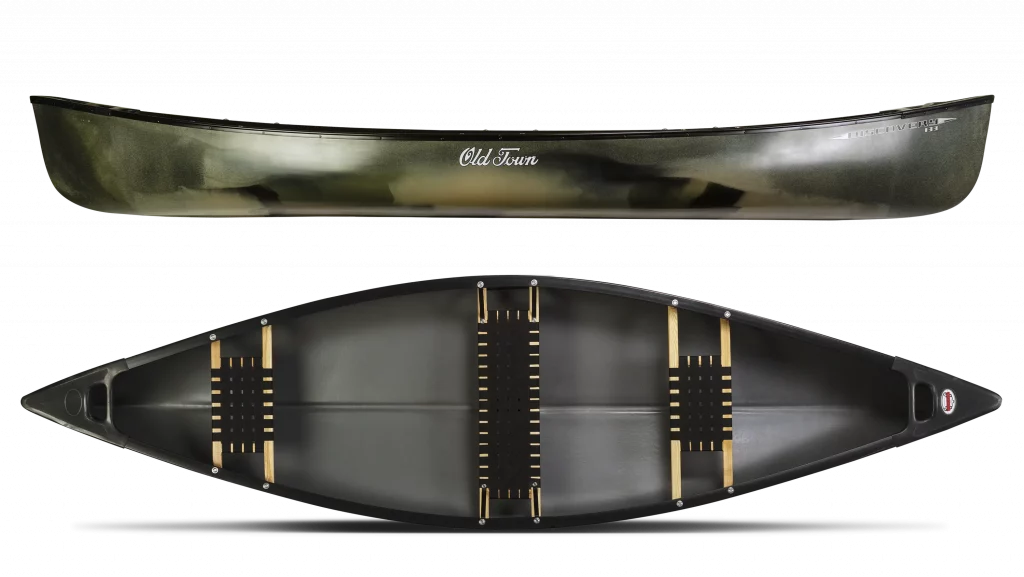
Old Town is one of the oldest canoe makers still in operation. It has a legacy to protect therefore all the canoes that come out of its factories are top-notch.
The Old Town Canoe Discovery 133, for example, is a great choice for anyone looking for an all-purpose canoe. It’s stable and comfortable, making it ideal for both solo and tandem paddling.
Specs:
| Activity | Fishing, Hunting |
| Number of Paddlers | 3 |
| Material | Three-Layer Polyurethane |
| Length | 13 ft 3 in |
| Gunwale Width | 40.5 in | 102.9 cm |
| Center Depth | 14 in | 35.6 cm |
| Assembled Boat Weight | 78 lbs | 35.3808 kg |
| Price for 2nd | $800 |
The Discovery 133, with its triple-layer polyurethane hull construction, is extremely durable, so it can handle a variety of different water conditions. Its extra-wide beams and shallow arch also mean it has rock-solid stability.
All of this no-frills goodness comes with an $800 price tag for a used one and $1349 or more if you get one fresh off the shelf.
Nova Craft Prospector SP3 16’
Nova Craft has its roots in Canada in 1970. They started with fiberglass but have since employed other composite materials for their boats.
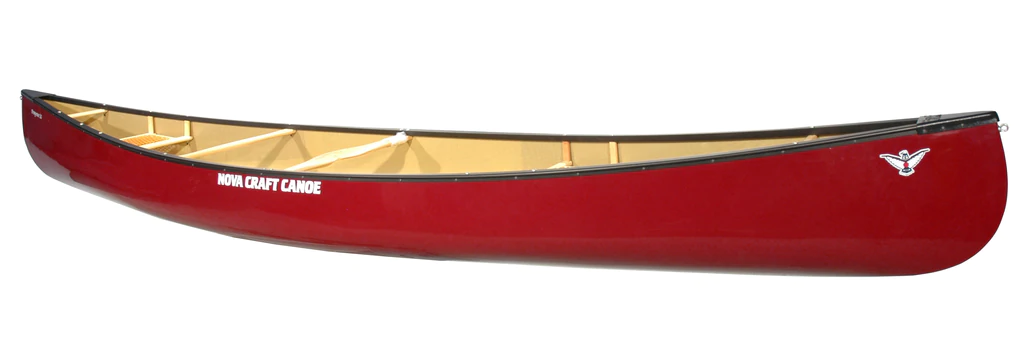
| Activity | Fishing, Hunting |
| Material | Three-Layer Polyurethane |
| Weight | 90 lbs / 40.8 kgs |
| Length | 15 ft 4 in / 476cm |
| Gunwale Width | 36 in / 91.4cm |
| Center Depth | 14.5 in / 35.6cm |
One of the first things you’ll notice about the Prospector is its shallow arch hull gives it a self-righting aspect which means it’s incredibly stable. It’s similarly made out of a three-layer polyurethane which is extremely tough.
You could drop this canoe from a 20-story building and it would still come out unscathed. It weighs a bit more than most at 90lbs but that’s because of the extra durability provided by the polyurethane.
Both the weight and the shallow arch design gives it the ultimate stability. You can get a used one for around $950 and a cool $1600 for a brand new one.
Esquif Blast (Whitewater)
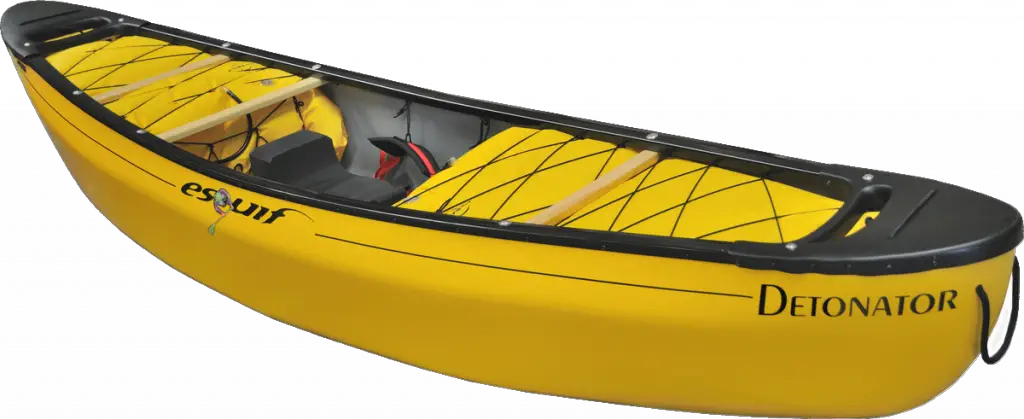
Esquif is a relatively young company that got its start in 1997. Its passionate founder, Jacques Chasse, is also an avid sportsman who only desires to give the brand’s customers the best equipment possible.
| Activity | Extreme paddle sports |
| Material | T-Formex |
| Weight | 24kg | 53lbs |
| Length | 13 ft | 3.96 m |
| Gunwale Width | 28.5 in | 72.4 cm |
| Center Depth | 16 ft | 40.6 cm |
The Esquif blast is a no-frills whitewater tandem canoe. The rounded bottom gives it some much-needed maneuverability which means it can withstand the most radical waters. As such, it has become a favorite among slalom paddlers.
If you’re looking to get into some gnarly whitewater paddling, this one will set you back by $900. Brand new, however, and you’re looking at a bank account that’s $2000 lighter.
Clipper Tripper (Kevlar)
Another excellent canoe company coming from Canada, Clipper has been in the business since 1976. Like most canoe makers, they started with standard materials but has began innovating with composites in recent years. In fact, their iconic Tripper model has become one of the most sought-after bang-for-your-buck canoes.
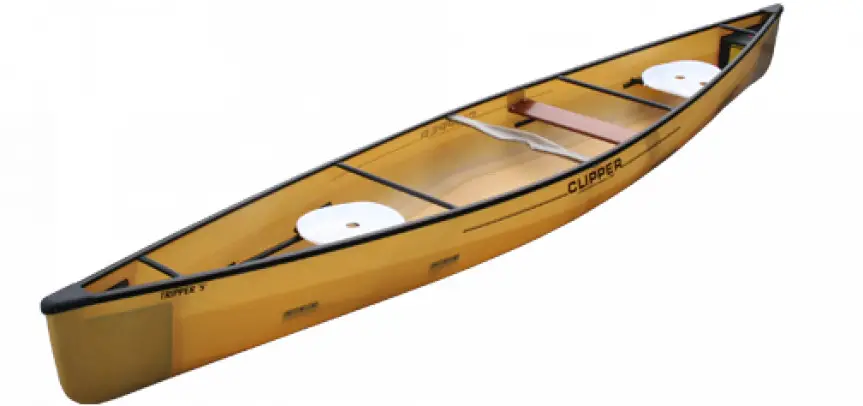
| Activity | Tripping, Hunting, fishing |
| Material | Kevlar |
| Weight | 127.8 lbs / 58 kg |
| Length | 17 ft 6 in / 533.4 cm |
| Gunwale Width | 36 in / 91.4 cm |
| Center Depth | 21 in / 53.3 cm |
The Tripper is an extremely versatile canoe that is at home at large lakes, open ocean, and even whitewater because of the stability provided by the shallow arch hull design.
And as a testament to its durability and ease of use, it also has the record for the longest canoe trip from Calgary all the way to Brazil. If you’re buying it new, be prepared to dole out up to $2,200. If you’re buying it used, however, this one can be had for around $1,400.
Mad River Explorer
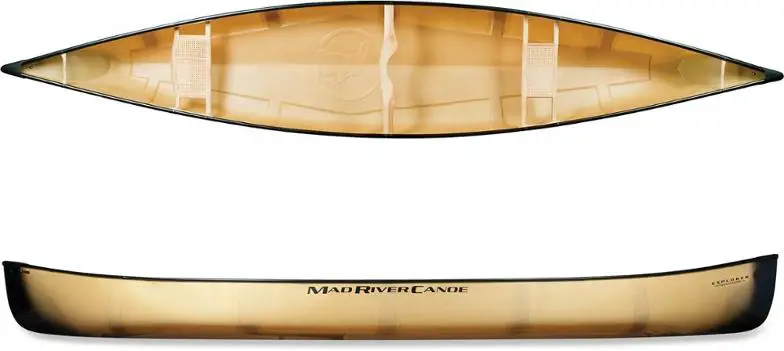
Mad River Canoe Company was established in 1971 by Jim Henry. He built and raced the Malecite model which won him the Downriver National Championship.
| Activity | Hunting, fishing, cruising, light whitewater |
| Material | T Formex |
| Weight | 77 lb / 35 kg |
| Length | 15 ft 11 in / 486 cm |
| Gunwale Width | 35 in / 90 cm |
| Center Depth | 14.5 in / 37 cm |
While it’s not the famous Malecite, the Explorer is also an impeccable canoe that can be used in multiple scenarios. Its flared design makes it easy to keel which is perfect for fishing. And since it’s made from T Formex, it’s also incredibly lightweight as well.
Buying it brand new would cost around $2,200 while getting it used would cost you around $1,400.
Grumman Square Stern 17
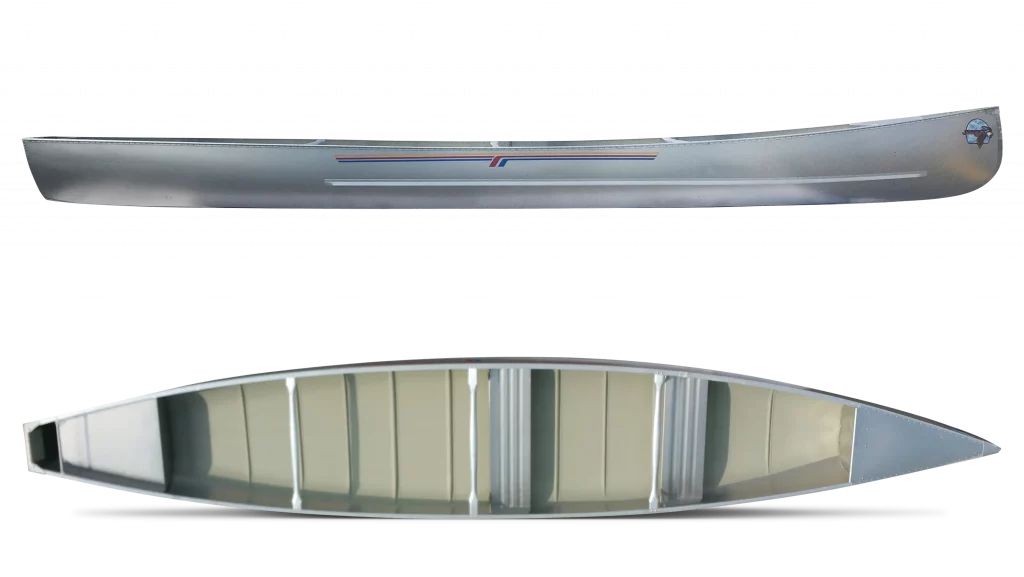
Grumman started as an aircraft company and was one of the heroes of World War II as they produced most of the lightweight fighter planes designed for aircraft carriers.
However, they made the pivot to canoes once the war was over when the company president was forced to portage his canoe and found it too heavy and cumbersome.
| Activity | Recreational, Hunting, Fishing |
| Material | Age-hardened, stretch-formed aluminum alloy |
| Weight | 85 lbs | 38.5 kg |
| Length | 17 ft | 518.1 cm |
| Gunwale Width | 6.63 inches | 16.76 cm |
| Center Depth | 13.13 inches | 33.78 cm |
The Grumman Square Stern 17 is a lightweight but incredibly durable canoe that can withstand everything you throw at it with minimal maintenance. And even if something does damage it, it’s quite easier to repair an aluminum alloy canoe than any other material type.
In addition, the Grumann’s square stern lets you add up to a 5HP outboard motor for hauling fishing or camping equipment.
H2O Pro-Lite Prospector
With its founding date of 2005, you’d think H2O is new to the paddlesports industry. But, with the company’s reputation and pedigree, you’ll soon realize that they’re just as good or maybe even better than their veteran competition.

| Activity | Recreational, Hunting, Fishing |
| Material | Kevlar, Carbon |
| Weight | 85 lbs | 38.5 kg |
| Length | 18 ft 6 in | 563.88 cm |
| Gunwale Width | 36 inches | 91.44 cm |
| Center Depth | 21 inches | 53.34 cm |
One of the strong points of the Prospector is its semi-round keeless hull combined with a moderate rocker making it easy to make sensitive pivots and sharp turns. The Pro-Lite versions are available in a couple of composite material choices.
Kevlar and carbon, or a combination of these two materials are available. Because of these premium materials, at a brand new price point of $2,500, you won’t get much of a discount if you get it used and in good condition.
You’re looking at a price of $1,950 for a used one, but it’s still a great price for the premium construction.
Souris River Quetico 18
Souris River is one of the few companies that specializes in one type of material construction – lightweight epoxy-Kevlar. And their expertise shows in their output as they’re able to produce extremely lightweight canoes that does not compromise on durability.
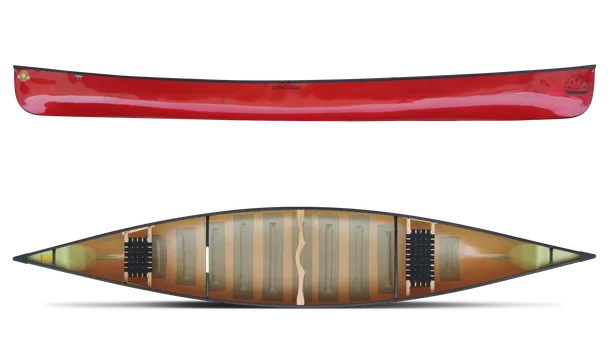
| Activity | Tripping, Hunting |
| Material | Kevlar |
| Weight | 49 lbs | 22.22 kg |
| Length | 18 ft 6 in | 563.88 cm |
| Gunwale Width | 36.5 in | 90.17 cm |
| Center Depth | 14 in | 35.56 cm |
One example of Sours River’s mastery of epoxy-Kevlar is in their Quetico 18 model. Users are simply amazed by how lightweight such a durable canoe can be.
But that’s not all that users are raving about. It’s stability which is a direct cause of its shallow arch bottom, is a strong point too. Because of its premium build quality, brand new Quetico 18s usually cost upwards of $2,600.
But, if you’re looking at a well-maintained used one, then you can get a significant discount as it usually sells for $1,600 in online marketplaces.
Wenonah Encounter Solo
There’s probably no name in paddlesports as ubiquitous as Wenonah. The name is synonymous with good quality equipment. The company has been at the top of everyone’s list for more than 50 years.
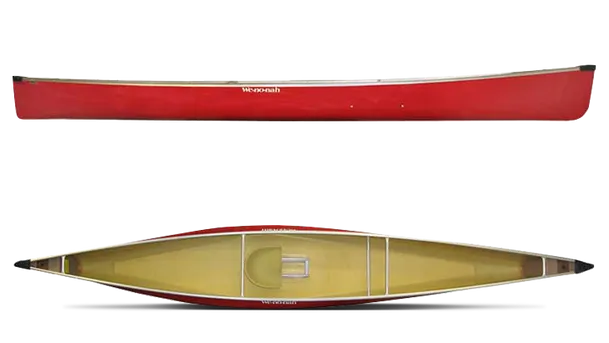
The company’s founder, Mike Cichanowski, is a natural explorer and has transferred all his energies to creating the ultimate exploration canoes.
| Activity | Expedition, Fishing |
| Material | Tuf-Weave Flex Core (Fiberglass composite) |
| Weight | 54 lbs | 24.5 kg |
| Length | 17 ft | 518.16 cm |
| Gunwale Width | 31.5 in | 80.01 cm |
| Center Depth | 14 in | 35.56cm |
The Wenonah Encounter Solo is a real outdoorsman’s canoe. Its lightweight Tuf Weave construction is meant to be portaged by just one person.
It’s designed to be used by large people that has enough buoyancy for all the cargo space they need for a long-haul solo expeditions. A rugged outdoorsman can expect to pay around $2,900 for a brand new Encounter and around $2,000 for used one. By our book both prices are well worth it because of all its benefits.
Clipper McKenzie
Another excellent canoe company coming from Canada, Clipper has been in the business since 1976. Like most canoe makers, they started with standard materials but has began innovating with composites in recent years.
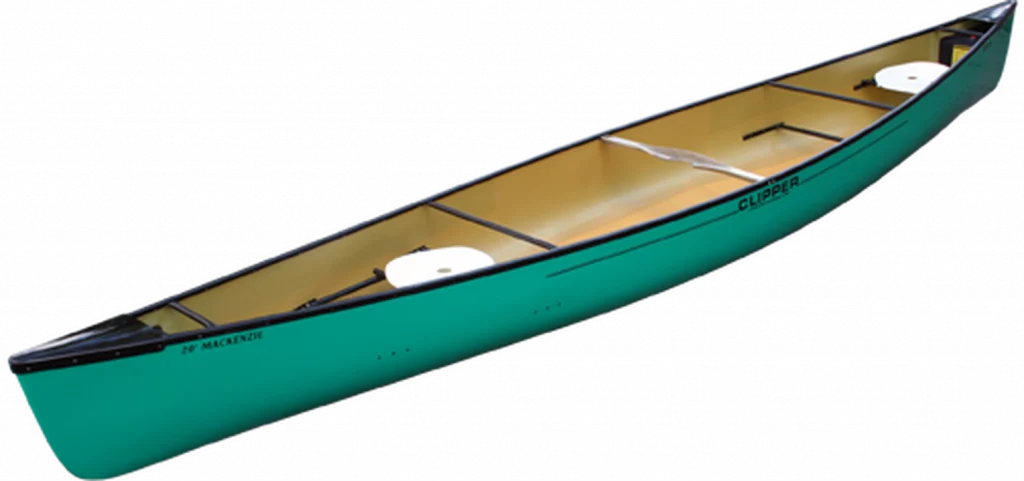
In fact, their iconic Tripper model has become one of the most sought-after bang-for-your-buck canoes.
| Activity | Expedition, Fishing |
| Material | Kevlar |
| Weight | 70 lbs | 31 kgs |
| Length | 18 ft 6 in | 563.88 cm |
| Gunwale Width | 37 in | 93.98 cm |
| Center Depth | 16 in | 40.64 cm |
The Clipper Mackenzie is a touring canoe through and through. It’s can support up to a whopping 1400 lbs. Up to 3 people can paddle and it’s buoyant enough to be able to bring all the necessities for a multi-day camping trip. It comes at a brand new price of $2,950 and a used price of $2,000.
Wenonah Minnesota II
Wenonah’s dominance in the canoe-making industry is pretty obvious as three of their models have made the cut for our list. A Wenonah canoe’s longevity and durability is second to none.
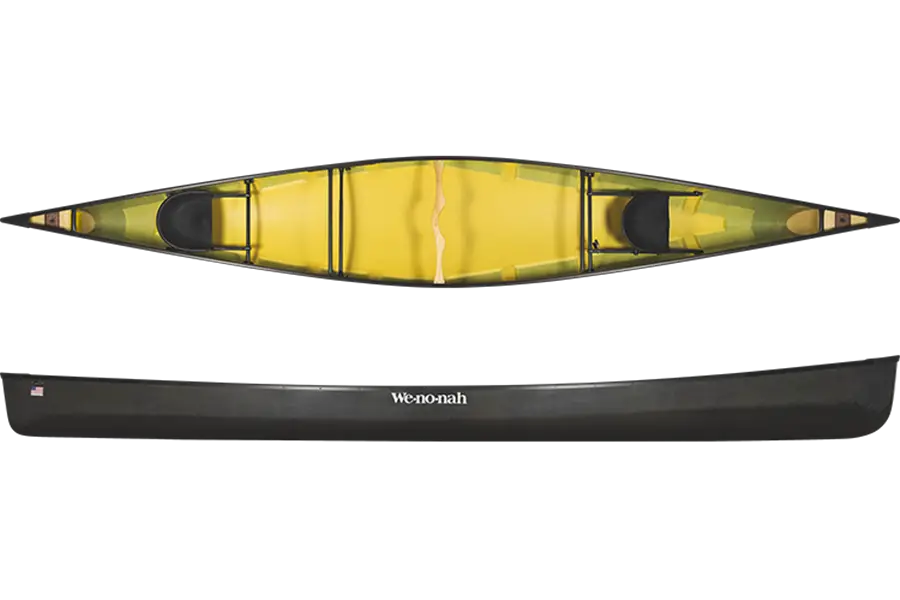
| Activity | Performance Touring |
| Material | Tuf Weave Flex Core (Fiberglass and polyester composite) |
| Weight | 42 lbs | 19.05 kgs |
| Length | 18 ft 6 in | 563.88 cm |
| Gunwale Width | 33.5 in | 85.09 cm |
| Center Depth | 13.5 in | 34.29 cm |
Unlike the Encounter Solo, the Wenonah Minnesota II is fun to paddle even it’s not loaded. It’s an extremely versatile canoe that glides smoothly no matter the conditions. Users also praise its impeccabl tracking performance.
The proprietary Tuf Weave technology gives the canoe the performance and lightweight construction fiberglass, and the integrity of weaved polyester resulting in a durable lightweight canoe that is just as at home in calm lakes as they are in raging rivers.
So, it’s understandable that Wenonah would price the Minnesota II at $3,150. But, at a bargain price of $1,850 average selling price,
Wenonah Minnesota III
The Wenonah Minnesota III is a canoe that has been designed to be paddled by three people, with plenty of room to carry all of their gear.
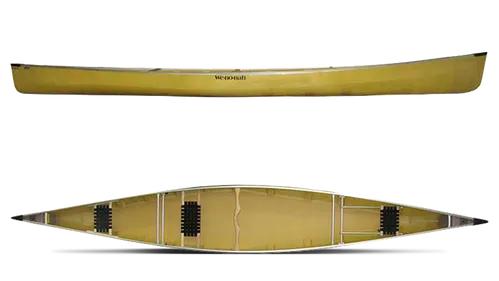
Aside from the extra space, the Minnesota III also features more comfortable seating and more stable hull design, making it ideal for carrying one passenger.
| Activity | Tripping with a large Group |
| Material | Tuf Weave Flex Core (Fiberglass and polyester composite) |
| Weight | 55 lbs | 24.94 kg |
| Length | 20 ft | 609 cm |
| Gunwale Width | 35.5 in | 90.17 cm |
| Center Center Depth | 13.5 in | 34.29 cm |
With its superior stability and comfort, the Minnesota III is an excellent choice for those who want to enjoy a paddling adventure with family or friends.
With a price tag of $3,500 for a brand new Minnesota III and a significant reduction to $2,150, it’s a small price to pay for the convenience of using just one canoe for the whole family.
Tips to Buy Cheap, Reliable Used Canoes
There are four basic to find inexpensive used canoes. And in this section, we’ll go in-depth with each one.
Setting the Search Term
When looking to buy a used canoe, it is important to set the search term correctly. The search term should include the type of canoe you are looking for, the size of the canoe, and the material the canoe is made from.
For example, if you are looking for a used fiberglass canoe, you would set the search term as “used fiberglass canoe.” So, the most important part of setting the search term is to narrow down your search with specific details.
You can either look for a particular brand, model, specs, or other specific details. This means it’s important to consider exactly what you intend to do with your canoe.
So, do you need a tandem canoe or a solo one? Will a fiberglass canoe be good for the lake that you’d like to frequent or will a kevlar construction be best? These are important questions that you need to answer for yourself before you even enter a search term into your browser.
By doing this, you will be able to find canoes that match your specific criteria.
In addition, setting the correct search term will also help to ensure that you do not end up with a canoe that is too small or too large for your needs. With a little bit of planning, you can easily find the perfect used canoe for your next adventure.
Ask Lots of Questions Before Buying Used Canoes
When you buy used equipment, it’s important to ask the right questions to make sure you’re getting a good quality product.
It’s also important as sometimes you’ll be able to clearly see where the owners might be hiding a couple of details such as damages.
Here are some of the best questions to ask:
How Old Is The Canoe?
I do admit that age isn’t necessarily the best indicator of a canoe’s quality. In some cases, a 1-year-old canoe can be more worn out than a several decades-old canoe.
However, knowing when the canoe was purchased and observing the degree of wear on the canoe can tell you how the owner took care of the canoe.
How And Where Has The Canoe Been Stored?
Now that you know how old the canoe is, it’s important to directly ask the owner specific questions about how they took care of their canoe. One of the best ones is where and how the canoe was stored when not in use.
This can reveal a lot about the type of wear that you should look out for. Kevlar, for example, can wear out easily especially if it’s not maintained properly.
Have You Done Any Repairs?
When it comes to canoes, structural integrity is of paramount consideration. Even the slightest damage could mean the difference between life and death in certain conditions.
So, it’s important to know whether there were already repairs done on the vessel. This eliminates the element of surprise when they do get broken again due to compromised integrity.
What Trips Have You Done In This Canoe?
Background questions like what trips have you done in this canoe can tell you a lot about a canoe. The most important one is what the canoe is capable of.
Furthermore, asking this question can also further reveal the type of wear the canoe may be hiding beneath its surface.
Test-paddling a Used Canoe (If You Can)
One of the most crucial benefits of buying a used canoe is that the owner might even let you test the canoe before actually buying the canoe. This would let you get a feel of the canoe which can help you solidify your choice.
But, more importantly, this could reveal whether the owner is saying the truth about the canoe.
Avoid Canoes with Severe Damage
Canoes are meant to be used in rugged conditions and you can expect some wear and tear on a used canoe.
However, there are certain types of wear that can indicate compromised structural integrity which can be catastrophic for you given the right conditions.
Absolutely don’t accept used canoes if they have hairline cracks, deep scratches, or worn Gelcoat.
FAQs
How much does a good canoe cost?
Good canoes that last long cost around $1,000 to $3,000 brand new. However, used once can cost much lower, especially if you know what to look out for.
How long are canoes good for?
Good canoes can usually be of service for around 10-15 years. However, certain canoes can basically last a lifetime if given the proper care.
What is a good first canoe?
The best first canoe is one that is versatile. As a novice, you might not know what you want out of your paddling experience yet. So, getting one that can handle everything you throw at it might be the best so you’re prepared for whatever happens. You can also find a specialized canoe later on.
Is a 14-foot canoe big enough?
A 14 ft canoe is enough for general-purpose canoeing. It’s not too big for a solo paddler and not too small if you intend to use it as a tandem canoe.
Final Sentences
Canoes are an excellent way to explore rivers, lakes, and streams. They are relatively easy to maneuver and provide a great workout. However, canoes can be expensive, especially if you opt for a new one.
A used canoe can be a great alternative, and there are several reasons to purchase one.
First of all, used canoes are often just as sturdy and reliable as new ones. Secondly, they are much more affordable. In addition, purchasing a used canoe helps to support conservation efforts. When you buy a used canoe, you are preventing it from ending up in a landfill.
Finally, used canoes often come with a rich history. Each one has its own story to tell, and that is part of the appeal. For all of these reasons, buying a used canoe is a great option for anyone looking to explore the wonders of the natural world.

3 thoughts on “How Much Are Used Canoes?”